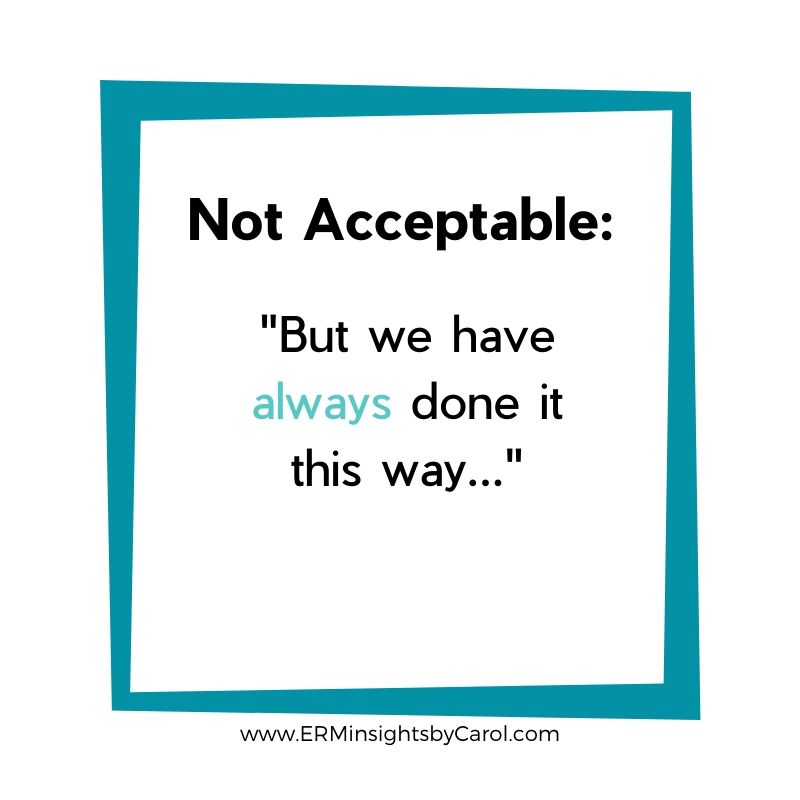No doubt you’ve attended presentations that were unengaging and downright boring. You were glad they were over, but also upset that the last 1-2 hours of your life were a waste.
Being on the other side can be even more frustrating, even demoralizing…
You spend hours developing an extensive 30 (or even 50!)-slide PowerPoint presentation. Around slide 10 or so, you begin noticing yawns, blank stares, and attendees looking at their phones or typing on their laptop. At the end, no one has any questions because they weren’t really paying any attention to begin with.
After experiencing this early on in my ERM career, I began realizing that I needed to be looking at presentations a little bit differently.
ERM presentations are more than reports…they are a vehicle for engaging with key stakeholders. The key word is engage, which means to “occupy, attract, or involve (someone’s interest or attention; participate or become involved in” your stakeholders.
In a recent article, I explain how ERM outputs have to be tailored to the stakeholder’s needs.
Presentations take outputs and go one step deeper in a specific area. For example, Your Chief Risk Officer has asked you to “present” to the executive team on an ERM topic, like risk appetite.
Before building your presentation, you need to first decide if the purpose is to solicit information or provide information.
In my experience, there are two ways ERM presentations can be developed.
- You develop slides with lots of information and do most of the talking…
- You ask some key questions and solicit information from your audience. They do most of the talking. You’re not only interested in information the audience says directly to you, but also any substance from conversations amongst themselves.
If your purpose is to educate your meeting participants, then choose option #1. But even then, you can embed parts of option #2 to increase the interaction with everyone.
If the purpose of your “presentation” is to conduct a workshop or solicit information, you’ll definitely want to opt for option #2.
Let’s take risk appetite for example…
You will need to solicit information to better understand the level of risk your organization is willing to take in pursuit of strategic objectives. But asking these types of questions may make the executives and other stakeholders nervous or hesitant to speak up. This is something you’ll have to overcome…you’re not only interested in what the audience says to you, but also what they’re saying to each other.
In a recent workshop for a client, I used two methods to overcome the nervousness:
- Broke them into small groups for a short time frame (approximately 7 minutes) and gave them 3 questions to discuss as a group. When time was up, there was a group report out to see where everyone landed on the questions. This prompted fantastic discussion, as they were exposed to different perspectives and experiences.
- Applied risk to everyday life. Before delving into the harder topics, I mentioned how personal preferences in life can impact business decisions. By giving examples of different personal examples of risk taking (jumping out of an airplane or parasailing versus flying a kite), they got a good laugh and started comparing where each of them stood on the scale.
Regardless of which style you choose, here are 4 key things to keep in mind when you develop your ERM presentations:
- Don’t rush through the topic. Take your time. As I explain in the prior article on outputs, understanding the audience’s needs and preferred communication style is crucial for delivering a presentation that is clear and succinct.
- Avoid ERM jargon. Don’t use risk management phrases like impact, velocity, or likelihood for example. Instead, risk terminology should be in a language that speaks to your audience. Examples can include money, performance goals, reputation, etc. To learn more, check out Make your Words Count: Translate Risk Terminology to Fit the Business.
- Think about how you can change from a lecturer style to discussion/interaction so you can understand where stakeholders stand.
- Get out of thinking that because your organization conducts meetings and presentations a certain way that’s how you must do it. In order to be valuable, ERM presentations have to be unique since you’re often talking about sensitive or unfamiliar topics.
This last point is especially important. Simply following a standardized approach may be comfortable, but it won’t produce a presentation that executives find valuable. Unfortunately, many risk professionals prefer to not rock the boat and stray outside the norm too much.
Therefore, it’s not surprising that 40% of executives claim they are “not at all” or “minimally” satisfied with the quality of reports they receive according to NC State’s 2019 State of Risk Oversight report.
Real world example…developing an engaging ERM presentation that served both purposes of soliciting and providing information
Let’s talk more about that workshop I mentioned earlier.
ERM was a new topic for this board of directors, so they needed a bit of an introduction on what ERM is and why it’s important.
Although I had a vague idea of preferences, I didn’t have much to go on. One key consideration was that my presentation was right in the middle of the group’s quarterly board meeting…I knew they would probably be on information overload by the time my turn rolled around.
So instead of developing this big presentation with 30+ slides and talking for an hour, I felt that I needed to have something more interactive so they would get the most value out of my time with them.
Therefore, I split my presentation into three parts and only provided hard copies at the beginning of each section.
The first section of the presentation was basically a primer on what ERM is and why it’s important. I opened things up by asking participants to share their thoughts and then I provided more information.
Instead of including this information in the handouts, I wanted them to write down in their own words their thoughts on ERM. After all, research has shown that handwriting information increases the odds of remembering it.
We went on to discuss governance and risk appetite during the session. Each of these sections was structured like the first because I wanted participants to reinforce these concepts in their own words.
In the end, the discussions that ensued during this session were very valuable in helping me understand where the organization currently stands and where they want to go. But it was also extremely helpful for them to learn from each other!
It’s easy to think that ERM presentations can be something you put together quickly. But as experience has shown me, they require careful thought to ensure they deliver the value stakeholders seek to fulfill their decision-making and oversight roles.
How do you handle ERM “presentations”?
Do your executives and other stakeholders find them valuable for managing risks and opportunities to the organization?
This topic isn’t discussed a lot, but it is so important for ensuring ERM adds value to the organization and isn’t seen as another compliance exercise.
Share your perspective by leaving a comment below or join the conversation on LinkedIn.
And if you are struggling to develop ERM presentations that executives, the Board, and other stakeholders find engaging and valuable, please don’t hesitate to reach out to me to discuss your specific situation today!









